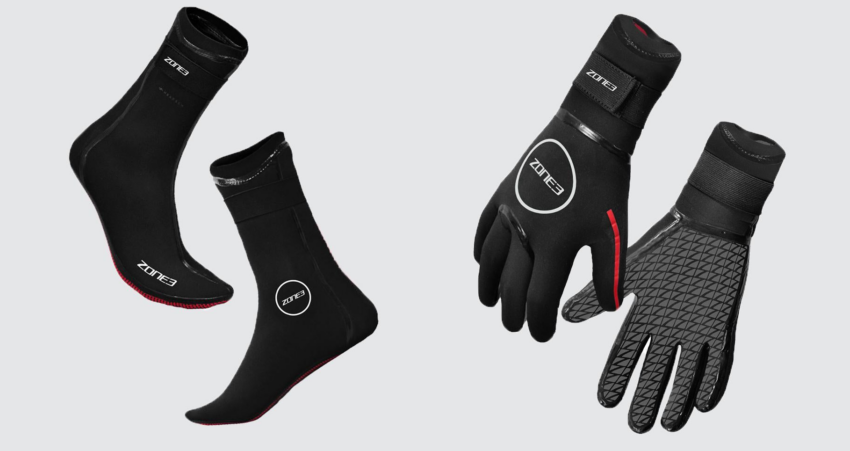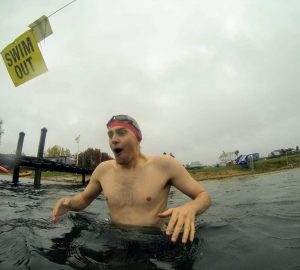
Should you accessorise for cold water swimming?
I’ve recently been sent some Zone 3 Heat-Tech neoprene gloves and socks to try out. This prompted me to consider the pros and cons of accessorising with neoprene for cold water swimming.
The question is: is that a good thing? Surely, yes! Why suffer pain if you don’t need to?
Actually, there are a few reasons why you might be better off without.
First, safety, especially if you’re not wearing a wetsuit. Discomfort in your extremities encourages you to leave the water, hopefully long before your core temperature starts to drop and you put yourself at risk of hypothermia. Accessorising may tempt you to stay in longer than is sensible.
There is an obvious solution to this: set a maximum time limit and don’t exceed it – but also remember that your time limit is just that. It’s not a target. You can always get out sooner.
Second, and this is important if you are changing outside in the cold, gloves in particular can slow you down while getting dried and dressed. The time you spend removing gloves is time you could be adding layers. You can mitigate this by pulling on a changing robe to protect you from the wind before removing gloves but they will still slow down your dressing time.
Third, accessories are a hassle. Not only do they make swimming feel clumsy, you need to rinse and dry them after each use and find somewhere to store them. It’s more stuff to remember for your swim, and it takes time putting them on as well as taking them off.
That said, apart from reducing discomfort, there are other benefits to accessorising with neoprene for cold water swims.
Most obviously, numb fingers after swimming are a nuisance. I’ve struggled to unclip my tow float or do up the zip of my coat many times. However, mostly this is little more than an inconvenience and full function is restored as soon as your hands rewarm.
That said, it is possible to cause long-term damage to your extremities either through chilblains or other non-freezing cold injury. Also, you suffer from Raynaud’s, your rewarming may take longer than normal and may result in pain. If you find that numbness or lack of dexterity continues after rewarming, then wearing gloves and socks on future swims might be prudent.
I’m also keen on wearing neoprene socks if there is a risk of physical injury from sharp objects or for comfort if I’m wading into water over pebbles or an unknown surface, and that’s true if the water is warm, too. If there is ice in the water, gloves can help protect your hands against sharp edges.
Another occasion where accessorising would be useful is if you want to do a wetsuit swim in cold water. I know some people continue open water training in winter, dressed head to toe in neoprene. There wouldn’t be much point in putting on a wetsuit if you have to leave the water after a few minutes because it was too uncomfortable on your feet and hands.
If you’re taking part in a winter swimming event (and some winter swimming challenges), neoprene accessories are not usually permitted, so you should probably do at least some of your swims without, to get used to it before your event. Apart from that, as long as you are aware of the risk of staying in too long and make sure you don’t, and if you don’t mind the faff, then go ahead and use them. Personally, if the water is above around 6 degrees, I don’t normally bother but their appeal increases as the temperature drops. I find that if my fingers get too cold for too long, they can feel fat, awkward and clumsy for several hours after they’ve warmed up again, and I don’t like that.
Regarding the Zone 3 accessories themselves, they do exactly what they’re supposed to. The Velcro straps around the wrists and ankles do a good job of keeping the water out, and my fingers and toes were comfortable throughout my 10-minute swim in 6-degree water, whereas normally they’d be starting to hurt. The gloves come in five sizes. I chose mine based on the size guide but found them a little tight. This was good for swimming – certainly far better than loose-fitting gloves that fill with water – but meant more time in taking them off after swimming. If you’re wearing a wetsuit, both the ankles of the boots and the cuffs of the gloves are long enough to tuck inside your sleeves and legs.









